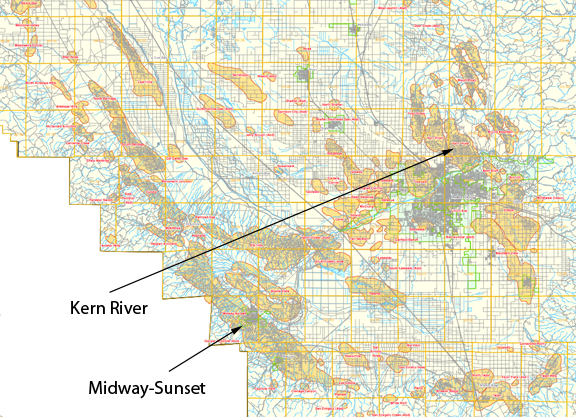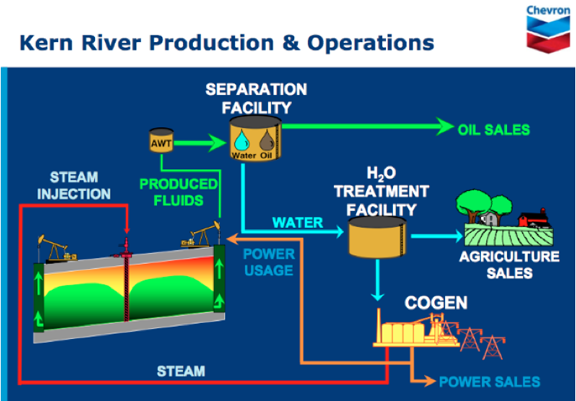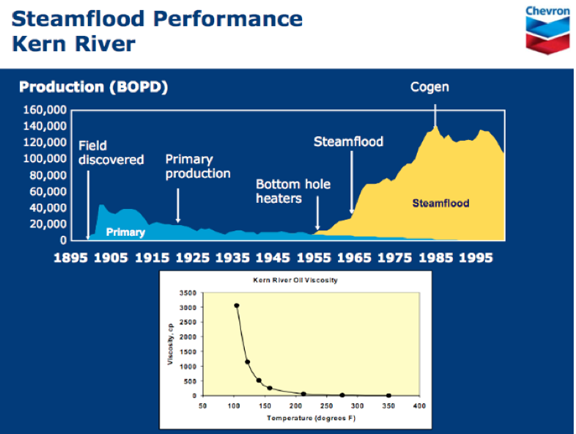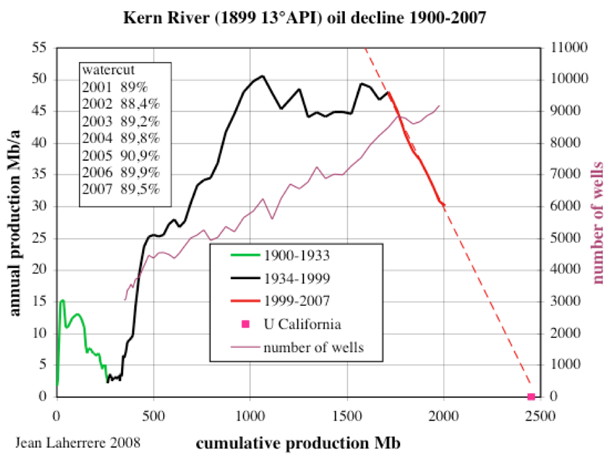Tech Talk - The Heavier Oils of California's Kern Valley
Posted by Heading Out on June 26, 2011 - 9:50am
The Kern River field was first found by a wood cutter and his son, who began digging with a 3-inch auger after being asked to drill a well below a seep on the Kern River shore on the Means property. They found oil at a depth of 13 ft. They then dug out a larger hole, using a pick and shovel to create a larger access from higher up the river bank down to that oil level, and then drilled down an additional 30 ft. after having fixed the auger to the end of a section of connected pipes. (This was done by manually turning the auger). The well then started flowing, filling the excavation at around three bd. That oil was then taken and used as boiler fuel to power a more conventional drill that, nineteen days later, reached another producing horizon at a depth of 256 ft. and became the first commercial well in the field. By 1904, the field was producing 17.5 million bbl/a year, at which it peaked.
It is important to distinguish the different fields in the region, since there are many fields around Bakersfield, each having different histories and projections for the future. The Kern River field, for example, has produced roughly 2 billion barrels of oil since that first well, with about 476 million barrels estimated as being still available.

The Kern Valley rapidly became the largest oil-producing region in the state, particularly since the arrival of the railroad in 1902 made it possible to develop the adjacent Midway-Sunset field, which remains the largest oilfield in the State. As a result, by 1904 California was producing more oil than Texas. Times have changed a bit since then, and while the Midway-Sunset claims to remain the largest oil producing field within the lower 48 states (note that this doesn’t include the offshore Gulf), the largest operator in the field now only produces some 29,000 bd.
Gail Tverberg visited the production facilities at the Kern River field back in February 2009 and gave a more detailed description of the field and the work Chevron is doing than I plan to cover today. (There is no point in trying to compete with her excellent report, though the reference to the video of the tour is now here, and the API picture record of her visit seems to have vanished.) The oil in the field is heavy, and so steam has been injected through one set of wells, in an increasingly refined operation, to heat the oil in place so that it will flow more easily to other collection wells, where it can be pumped to the surface.

The impact of the steam flood on production was dramatic, and has become the main method of production since it was introduced.

Gail also then posted a comment by Jean Laherrère on his estimate of future production from the field, showing its future decline, even with an increased number of wells, to a final estimate of production for the field.

My own visit to Bakersfield looked at a different way of producing the oil. The Bureau of Mines (as called then) brought large borehole mining equipment to Bakersfield and used pressurized jets of water to mine the oil and sand from around a well in the McKittrick field at a depth of 350 ft, bringing the mix to the surface, where the oil was removed, and the sand then re-injected back into the cavity. (This process was also successfully applied in mining small pods of uranium ore in Wyoming). The method has the advantage of getting all the oil from the formation section that was mined, with relatively little environmental impact, but the closure of the Bureau shut down this program. (Though I retain slides of the operation).
Some of the sand is even closer to the surface, as the initial well showed, so that strip mining of the region to produce the oil in the same way as in Alberta may be economic for the upper layers of some of the fields, were it not from the emissions that would come from the exposed oil and have a negative impact on local air quality.
The continued search for more efficient methods to extract a greater proportion of the remaining oil continue through the present. Methods have been proposed where the steam is generated using solar power to heat the steam. A small pilot plant was opened at the beginning of this year to demonstrate the feasibility of the technique, though as yet on too small a scale to produce a significant amount of oil. Higher temperature steam has been generated at other power plants using the same technological concept and so there may be a path forward for this development.
In the same way, there are some experiments to use the injection of oxygen and steam as a way of increasing production. The process is claimed to be able to work below the 2,000 ft limitation of conventional steam flooding to a depth of perhaps 3,500 ft. The claim is also that the costs are down at $4/bbl capital cost and $15/bbl operating cost to achieve this enhanced recovery. The process sounds a little too good to be true in the simple form in which it has been presented to date, but it illustrates the possible potential for improving absolute recovery levels above those presently available.
Unfortunately, the research budgets for finding enhanced ways of producing fossil fuels are not seen as having the critical importance that they may well have. The greater emphasis on advancing renewable forms of energy, and Washington power struggles have meant that energy research is not the hot topic it once was and the interest in developing new techniques to obtain more oil from existing fields is often subsumed by the desire in companies to grow reserves, even if only by purchase instead of discovery or development.
The debate over energy supply and the environmental impact of different sources of power continues to make it difficult to find satisfactory ways to supply California with the energy that its population needs. With the confines within which the oil and gas industry currently work in the state, it is hard to see any future gains in production over the levels of today, and the greater likelihood of declining production.




Wikipedia says 9,183 active wells. Like those corporations whose gross income exceeds that of many countries, a vintage field like Kern likely has more wells in it than whole nations. This is a big part of why the US continues to produce as much oil as it does, and continues to decline at a relatively gentle rate.
I spent three months in BK on a (non oil)project in 2009, and drove through that oil field just to see what it looked like. Quite amazing, all the pumpjacks just pumping away, new ones old ones, rusty iron, shiny insulated pipes - and NO PEOPLE - I saw all of two oil co pickups drive through in two hours. Get out of the car and just listen to the assortment of sounds coming from the pumps. It felt like something out of Mad Max - the apocalypse has happened, the people all gone, and these simple machines which weren't destroyed just keep on nodding away.
There are pumpjacks in parks by the river, farmers fields, office parking lots, probably even in a basement or two.
Oddly enough, BK was also one of the most cycle friendly cities I have seen - right up there with Calgary - these oil towns know how to do it. Cycle lanes on all the arterials, and a fantastic 30 mile long paved cycle path along the levee bank by the "river" (which is mostly a dry river bed), which has some really nice parks. Add in the flat geography and good weather and it was a great place for cycling - which many people did. They are happy to sell the oil to the poor folks stuck on LA freeways!
The town gets disparaged by everyone else in Ca, but you couldn't hope to meet a group of harder working, friendly and welcoming people. And the scenery up in the nearby mtns is great.
Heh, friend of mine who grew up in Bakersfield says when he was a kid (mid 80s) himself, friend, and his uncle were walking along the bank of that river when CRRACCK! goes a rifle shot. Uncle was 'Nam vet, yells at them to take cover, he yells at the marksman the usual - What do you want? We're armed and will return fire! We're getting up and leaving! All he got in response was more bullets. Had to wait for cover of darkness to hightail it out of there. Dunno if BK is still a haven for crazies like that.
Interesting about all the bike paths - maybe oil country makes for inviting topography, all those flat spots between the anticlines. Or lack of money for conspicuous consumption of fuel? The gasoline around the refineries in NW Washington state is paradoxically the 2nd most expensive in the state - lack of competing supply sources, plus Canadians crossing the border to get a (relative) bargain, so proximity to product generation infrastructure is no guarantee of low prices, it seems.
Unless I am mistaken, the oil industry in general has pretty robust revenues and profits.
Is it not reasonable for the oil industry to invest an appropriate amount of its accumulated cash to research and develop new, improved extraction techniques such as the oxygen/steam injection described in this post?
Would you please expand upon the idea/thought behind your last sentence?
Please enumerate the confines which currently exist.
Please describe the potential increases in oil production, as well as estimate any other (not pertaining to the volume/flow of oil production) results/impacts/consequences of removing or amending these confines.
Edit: The areas in the pic provided by KLR look pretty desolate. Perhaps solar PV arrays could be constructed around the pump jacks/pipes/roads etc. I assume the are receives sufficient insolation to adequately power the PV cells. Perhaps the pump jacks and pumps in the pipelines could be partially powered by the PV?
When the fields go 'dry', perhaps the wasteland could be further infilled with PV to power a greatly-reduced consumption of power by Californians down the road.
In Exxon Mobil's 2010 Annual Report, they show $307 Billion in Revenues, but only $1.01 Billion for Research and Development.
The major oil companies are very low tech industries. They probably buy most technology from equipment and services suppliers.
Read the rest of the article - HO provides a link to a article about a study to demonstrate the feasibility of using solar to power enhanced recovery, to some extent. I'm guessing that your reaction to the notion of solar power being used to extract more oil is the same expressed in this headline at the CleanTechnica blog: My Brain Hurts — Solar Powered Oil Fields are Coming. Sure, bit of cognitive dissonance - have to run at the moment, but throw in some apt analogies here - like taking the fees from burying asbestos to fund non-cancerous tobacco? Something like that, you get the picture.
And indeed this part of CA is a hot spot for solar, pun intended.
What the heck? Just two days ago Chris Nelder posted about visiting Kern: Heavy Oil of the Kern River Oil Field - GetRealList
Perhaps Chris will cross-post this article here. He says the array is powerful enough to drive 40 pumpjacks, so 228 to run all 9118 wells. This is Project Brightfield, btw, not the classroom-sized project HO is writing about, which is solar thermal where the heated water is injected for the huff-and-puff EOR. The company that built that is GlassPoint Solar.
The Brightfield PV array takes up 18 acres, and is built on the site of a former refinery. Some stories say 8 acres - maybe that was the original sizing.
A lot of the steam injection is done using co-generation now, improving overall efficiency.
I was at Los Alamos during what was the heyday of government funded energy research. Once Reagan got into office, the theory that such research could be performed more efficiently by the private sector prevailed, and the fraction of lab budget/jobs devoted to energy (as opposed to weapons) began shrinking rapidly. I'm with Heisenburg here, the oil companies have tens of billions per year available, and vast research teams. The only thing government funded research would do differently is to share the results with all the companies. The oil industry could create a sematech style consortium (semi-conductor companies got together to create a joint research institution, which would share results with all members). Surely big oil could do something similarly.
EOS, your idea seems to have merit.
As someone else pointed out up-thread, the oil extraction service companies (Halliburton, Schlumberger, etc) should be making appropriate investments, as they do a lot of the work and they are rolling in dough as well.
The same industry which trumpets that it provides 9.2 million jobs (see the oil and gas industry commercials with the sharp-dressed well-spoken upbeat woman on American tele)should be very interested in investing to continue their future performance for their shareholders.
And to clear up some apparent mis-understandings of my first post: Guilty, I did not read the whole article, however, my comment about using PV to power pumps etc. was an advocacy position on my part, not an expression of cognitive disconnection.
In fact, I would agree that using CSP to heat water into steam for EOR sounds like a good idea as well. Both PV and CSP seem like they offer potential for powering oilfield ops.
And when the fields are ultimately depleted, then the systems can potentially provide energy for folks living nearby.
Edit: I am still interested in information, leading to a discussion among the bright people (with many different experiences and perspectives)who frequent TOD, about the nature of the constraints preventing more energy production within CA. This discussion could include opinions/analysis etc. of the potential trades between environmental regulations and the CA energy supply.
Fascinating.... Not a single negative post so far. But let anyone raise the Alberta projects doing exactly the same things (simply using newer techniques), and the enviros go frothing-at-mouth crazy.
Does anyone follow the long time Kern Valley producer Berry Petroleum?
http://www.bry.com/index.php?page=about
http://www.fool.com/investing/general/2011/06/21/berry-petroleum-shares-...
Steam oxygen is a gasification mix. Are they really thinking of gasifying the residue from a previous steam flood? Why not license THAI and produce oil?
The oil industry is too proud to take and pay for anyone else's solution. They will rent, like Hughes tool bits, but never admit any one else has a better idea unless they can steal it.
For all: Sorry I’m late to the party…out buying production equipment all day. I’ll hit on several points brought up above from a very prejudiced position. First, for the most part the Big Oils gave up on researching EOR in the 70’s. And for two good reasons: 1) there wasn’t much left to do. For the last 40 years there have been improvements (especially using horizontal well bores) but for the most part the same methods used in the 50’s/60’s are used today. 2) With the exception of a number of showcase projects the Big Oils haven’t been into EOR in the US. The vast majority of old fields are operated by small independents. Thus the vast majority of EOR is operated by Little Oil.
Since the 70’s when Big Oil shut down their labs research has been done by the service companies. Hundreds of $millions in fact… covering all aspects in the oil patch: drilling including hz wells, EOR, frac’ng, seismic acquisition, Deep Water production systems and so forth. And yes, Halliburton has been one of the leaders in these efforts. And the reason should be obvious: service companies make a profit by selling SERVICES. But to sell services you have to have services to sell. ExxonMobil wasn't going to spend their research $'s and give the results away. And this has been very critical for the oil patch: thru the service companies, like Halliburton and Schlumberger, my little 4 man group has access to the exact same technology that ExxonMobil's hundred of thousands of employees have. We don't need to build a consortium of experts. We already have one...and they buy lunch. BTW: maybe I just haven’t seen it but I don’t know of a single govt research effort that has contributed even a minor bit of tech to the oil patch. Even the free govt $’s tossed to the oil patch for research hasn’t produced anything noteworthy IMHO.
PV: saw my first oil patch application about 35 years ago. Nothing big…just running some low power production electronics. Would an operator use a major PV array to run production equipment/EOR? Of course…why not? As long as it was more cost effective than the alternatives. No different than any other PV application in any other business. But it doesn’t matter if I’m making a gazillion $’s profit from my other fields: of I can’t economically recover a big capex expenditure for a PV application it won’t get done.
I haven’t seen it bought up but for those who are wondering: What’s left to apply EOR in the US? Not very much. Remember that the average US well produces less than 10 bopd. And the vast majority of those wells have undergone some form of EOR. A year ago a partner operating a new small oil discovery began doing EOR using an injection well for pressure maintenance. And doing it exactly as it would have been down 50 years ago: injecting produced salt water back into the base of the oil reservoir. Not doing it kinda like it was done. Not doing it with some newly developed chemicals or pump design. Doing it exactly as it was done the year I was born: 1951. No: there is no big untapped proven reserve of oil in the US waiting for a bunch of brain dead companies to apply EOR towards that they’ve carelessly overlooked. Production from the 3d largest oil producer in dominated by EOR of old fields.
Rock,
As usual, your posts are clear, to the point.
Do you have any perspective on what confines we need to eliminate in the CA oil/NG arena and what impact, expressed in terms of greater Ultimate Recovery and in increased future production rates, that eliminating the unstated confines would give CA?
Is one of the confines the restrictions on drilling off the CA coast? In addition, are there regulations/prohibitions on the apapplication of certain EOR processes? HO did mention the idea of strip mining certain shallow sandy formations were it not for air quality regs...how much more flow rate and ultimate recovery would that provide, and what would be the environmental consequences?
H - Another simplistic answer: in terms of PO it doesn't matter at all IMHO. Ban all oil/NG production in the state or open it up with no environmental restrictions at all. But that's not the whole story: CA needs all its natural resources that can be developed in an environmentally safe manner. From my perspective its about jobs and revenue for the state and private landowners. Again, IMHO, the debate about how much oil/NG is there to develop is pretty much a non-starter. Just do it, take care of Mother Earth and cash the check. PO is coming either way. A little more cash in the system won't hurt. But big pain still coming.
Rockman,
Please write to the "oil experts" at the NY Times. They published a story that contradicts yours. Perhaps auto company ad money is keeping the NY Times afloat.
I know that federal funding helped with the development of polycrystalline diamond bits (PDC's and done at
Sandia) and I believe helped a fair bit in the development of down-hole turbine motors (which originally came from the Soviet Union, but needed redesign IIRC).
I remember sitting in a meeting in Park City on drilling research when DoE was still being developed and two of the research heads of major oil corporations were chatting in front of me about why the Feds were doing this, when they had work going, and then someone mentioned how much the Feds were putting into it, and shortly thereafter both companies dropped the size of their research budget.
Even the free govt $’s tossed to the oil patch for research hasn’t produced anything noteworthy IMHO.
Well, in Canada at least, they did achieve something. The Alberat government set up a joint gov-industry funded research centre called Alberta Oil Sands Technology and Research .
So I guess you could say the companies outsourced much of their R&D to this group.
This group developed the steam assisted gravity drainage technique now in wide use, and probably quite a few other things - I'm sure Rocky Mtn Guy can fill us in on that.
Admittedly, the Ab gov had a huge incentive to develop a commercial process for u/g oilsands extraction, same as the US gov has a similar incentive to crack the (harder) nut of oil shale - though it does not seem to be actively pursuing this.
Aostra has been renamed a couple of times, but is still there three decades later and doing all sorts of energy related stuff.
Yes, the Alberta government spent roughly $1 billion on oil sands research through AOSTRA and other organizations. I did some IT work on one of their projects (a fireflood experiment which proved mostly that firefloods are hard to control), and my sister did some engineering work on several other of their projects.
Their big breakthrough was the SAGD in-situ process for extracting oil sands oil. SAGD allowed them to book at least 170 billion barrels of additional oil reserves, which at today's prices would be worth about $15 trillion. That's a 1.5 million percent return on their investment, which is not too shabby. I think it illustrates that R&D expenditures are not always a frivolous waste of government money. Sometimes they pay off big time (for the oil companies as well as for the Alberta government).
SAGD was an interesting example of government/industry cooperation. AOSTRA hit on the bright idea of sinking a mine shaft into the oil sands and drilling dual bore-holes out from it horizontally, injecting steam into the upper bore-hole and producing oil out of the lower bore-hole. However, this coincided with improvements in horizontal well drilling technology, so the oil companies said, "Why don't we just drill a bunch of horizontal wells off a gravel pad and save ourselves a lot of money?" And they proceeded to do that.
The SAGD technology would probably work very well in the California Kern River heavy oil deposits, since they don't differ much from Alberta oil sands (despite what the California politicians seem to think), but the California oil companies probably suffer from the Not Invented Here (NIH) syndrome that afflicts a lot of companies.
The US oil shale deposits would indeed be a much tougher nut to crack than the Canadian oil sands, and I don't think the US government or oil companies are putting much money into them any more. It would require an R&D program on the scale of the manned spacecraft program that landed a man on the moon to get a pilot project working, and the US doesn't seem to be up for that kind of research effort any more.